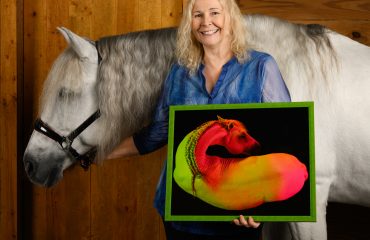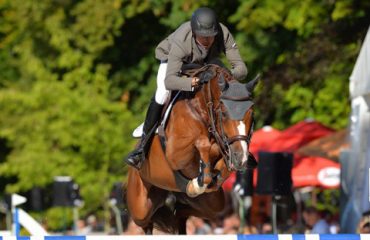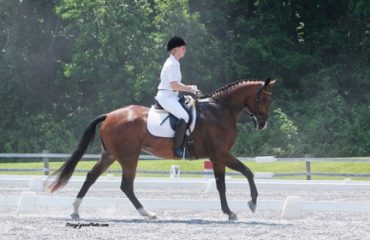
Richard Wheeler, DVM, was born in the U.K. and graduated from the Royal Veterinary College, London, in 2002. Dr. Wheeler then completed a two-year internship at Greenwood, Ellis and Partners (now Newmarket Equine Hospital) in Newmarket. In 2005, he moved to Wellington, Florida, to join Palm Beach Equine Clinic and he became a partner in 2009. Dr. Wheeler’s primary concentration is equine sports medicine. He is an FEI Veterinary Delegate for Show Jumping and Dressage and has authored several published articles on the topic of equine sports medicine. Dr. Wheeler has served on the board of the USHJA Horse and Rider Advocates Committee. In 2016, Dr. Wheeler became a founding director of the Sport Horse Research Foundation. Dr. Wheeler and his wife, Jessica, have two children. Do you have a question you want Dr. Wheeler to answer? Send questions to editor@sidelinesnews.com.
One of the most valuable aspects of working at a large specialty equine clinic is that we have a diversity of skill sets and knowledge, including sports medicine, surgery, radiology, internal medicine, dentistry, reproduction and alternative medicine. It’s very valuable for a practitioner to be able to seek other opinions, and this month I’ve called upon some of my colleagues at PBEC to help get you the best answers!
We purchased my mare 12 years ago. She is an amazing horse, but is now at a retirement facility. One morning, the retirement facility let us know that my horse wasn’t eating and that they thought she had been experiencing toothaches. We had it checked out and she was diagnosed with a rare tooth disease known as EOTRH. What causes this? Is there a cure to the condition? Are there signs to look for so that we can prevent this in my other horses?
Equine Odontoclastic Tooth Resorption and Hypercementosis (EOTRH) is a dental disease characterized by the dissolving of incisor and canine tooth roots. This is a condition mainly seen in horses of 15-plus years, and predominantly seen in warmbloods, Thoroughbreds and Arabians. I discussed the condition with PBEC’s Dr. Tyler Davis, who has a keen interest and experience in the field of equine dentistry.
Dr. Davis said that the disease has likely been present in the equine population for many years, but has only recently been recognized as a specific disease since horses are living longer and we’re paying closer attention to what’s going on inside their mouths.
We don’t know what causes this disease, but there are theories, including insufficient time spent grazing, age-related change, dental trauma and stress of mastication (chewing) on the teeth. Endocrine conditions like equine metabolic syndrome (EMS) and Cushing’s disease can increase the likelihood for EOTRH.
The cure for the disease is extraction of the affected teeth. Since we do not know what causes the disease, there currently is no preventive treatment.
Diagnosis is based on both a good oral exam by a veterinarian and oral radiographs of the incisors. Often the owner does not recognize the disease until it has progressed greatly. At this time, the owner may notice the horse has difficulty eating, or more commonly, will not take hard treats such as carrots. I had a patient that continued to eat carrots, but would only grab with its lips and then bypass its incisors to chew with its molars. It may simply be that a horse seems more irritable than normal or becomes difficult to bridle. We’re unable to prevent EOTRH, but with early detection, we can reduce any pain or eating-related issues associated with this disease. Early detection can be especially important with teeth affected by hypercementosis, as these roots become bulbous, which can destroy surrounding tissue and in my experience, make extraction more difficult.
There has been a lot of chatter recently about a common anticoagulant drug that is said to help prevent a life-threatening neurological complication of equine herpesvirus type 1 (EVH-1) infection. What are your thoughts?
There have been a few recent papers evaluating the role of coagulation in the neurologic form of EHV-1, and subsequently the potential use of the anticoagulant, heparin, as a treatment. This is very exciting, as there are currently limited treatment options for this rare but very dangerous strain of the disease. In one study from 2016, a Swiss research group administered heparin to approximately half of 61 horses infected with EHV-1 during an outbreak. The group that received the medication showed a lower incidence of neurologic signs (one out of 31) than the untreated horses (seven out of 30).
I discussed this topic with PBEC’s Dr. Peter Heidmann, who is board certified in large animal internal medicine.
Dr. Heidmann said that as with many scientific studies, there are limitations, and this is further complicated given the rare and unpredictable nature of the neurologic strain of EHV-1. The study does, however, suggest a possible benefit for the use of heparin and if low-molecular-weight heparin is used, the risk is minimal. While we need more studies to investigate the full potential of the drug for this indication, given the severity of the disease, it is certainly a treatment option to consider.
My horse suffered an injury to the foot, and after an MRI examination, a surgery called navicular bursoscopy has been recommended. Have you seen good results with this procedure?
I think this is a very useful procedure and one that is routinely performed at PBEC, so we’ve seen a good number of outcomes.
The procedure involves the insertion of an arthroscopy camera (think key-hole surgery) through the bottom of the digital flexor tendon sheath in the pastern region. A hole is then made between the tendon sheath and navicular bursa, giving the surgeon a good view of the navicular bursa, flexor surface of the navicular bone and adjacent deep digital flexor tendon. Given that only a small incision is required, the technique is relatively noninvasive and usually does not take a long time under general anesthesia. The navicular bursa is a small structure, and one limitation of the procedure is whether the specific injury is easily visualized. Often we can predict this from the MRI results.
My advice would be to make sure you select a surgeon who has plenty of experience with such procedures and make sure they have a chance to evaluate the MRI images prior to surgery. PBEC’s head surgeon, Dr. Brusie, has been performing this procedure for more than six years and has seen good results. In his experience, complications are rare.
As with most surgical procedures, there is rarely a quick fix; several months of rehabilitation and careful veterinary supervision, as well as good farrier care, will be important for success.
While each case is different, I am happy to say that since this procedure became available, I have seen many successful results with the horses returning to a similar level of training. In one study out of the U.K. in 2012, 61 percent of horses undergoing navicular bursoscopy returned to work sound, with 42 percent returning to their previous level of performance.













